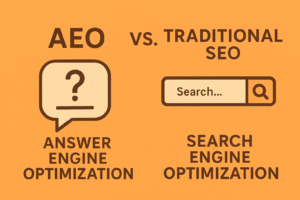Last Updated on 5 months ago by Hitakshi Parmar
By 2025, over 50% of online searches will be answered by AI-generated summaries instead of traditional blue links. You’re already falling behind if your content isn’t optimized for these AI-powered results.
AI search platforms like Google AI Overviews, ChatGPT, Gemini, and Bing Copilot are reshaping how people consume information. Instead of clicking through websites, users are relying on concise, direct answers provided instantly by AI. This shift demands a fresh approach to visibility online. It’s called Answer Engine Optimization (AEO).
In this guide, we’ll walk through the most effective AEO strategies you can use to rank in AI Overviews, win visibility in AI-driven answers, and future-proof your content for the next evolution of SEO.
What is Answer Engine Optimization (AEO)?

Answer Engine Optimization (AEO) is the process of optimizing your content so it can be easily found, interpreted, and surfaced by AI-based search tools.
These include:
- Google AI Overviews
- ChatGPT search integrations
- Gemini AI snippets
- Bing AI Copilot responses
AEO goes beyond traditional SEO. Instead of just ranking pages, the goal is to structure content that directly answers questions so it can be featured in AI-generated summaries, featured snippets, and voice search results.
How Is AEO Different From Traditional SEO?

Here’s a quick breakdown to help you understand the difference:
| Traditional SEO | Answer Engine Optimization (AEO) |
| Focuses on keywords and backlinks | Focuses on questions, answers, and context |
| Optimizes for Google’s algorithm | Optimizes for AI language models |
| Prioritizes ranking in search results | Prioritizes being selected for AI summaries |
| URL and site authority matter most | Clarity, structure, and semantics matter more |
| CTA-focused conversions | Trust-based informational delivery |
If you’re still only optimizing for traditional rankings, you might be invisible to AI search engines.
Why Does Ranking in AI Overviews Matter?
Here’s why AEO is now mission-critical for your business and content:
- Users rarely scroll when AI delivers a direct answer
- AI Overviews often skip website links altogether
- Brands that appear in AI summaries gain authority, trust, and visibility instantly
- It’s an opportunity to own high-intent queries without competing for top 10 positions
For digital marketers, content creators, and business owners in India and beyond, mastering AI search engine optimization is your edge in the next generation of search.
What Are the Best AEO Strategies to Rank in AI Overviews?
Let’s get into the actionable part. Here are the most important AEO strategies that can help you rank in AI summaries and overviews:
1. Create Answer-First Content
Start your content with the direct answer to the user’s query. AI systems prioritize content that gives:
- A clear definition
- A step-by-step explanation
- A bullet-point summary
Example:
If your keyword is “What is Answer Engine Optimization?”, your first 100 words should directly answer that in plain language.
2. Use Semantic Questions as Headings
AI loves structured content. Use question-style subheadings like:
- What is AEO?
- How does it work?
- Why is it important for small businesses?
- How do I optimize for AI search?
These headers help AI identify the purpose of your content. This question-led structure increases your chances of being featured in Google AI Overviews and other AI results.
3. Implement FAQ and How-To Schema
Use FAQ schema to wrap question-and-answer sections. It helps AI crawlers understand context and display your answers more confidently.
Also use:
- HowTo Schema for tutorials
- Article or Blog Schema with author, publishDate, and headline fields
This improves your chances to rank in AI Overviews and SEO for ChatGPT by making your content machine-readable.
4. Use Structured Lists and Tables
Content formatted as:
- Bullet lists
- Numbered steps
- Simple comparison tables
gets picked up more easily by AI models. These formats signal “direct answer” structure, making it easier for AI to extract key info.
5. Target Long-Tail and Conversational Keywords
Instead of chasing broad terms like “SEO”, go for:
- how to optimize for AI search
- best AEO strategies in 2025
- tips to rank in Google AI Overviews
- answer engine optimization guide for businesses
These long-tail phrases align better with user queries in AI platforms, especially voice search.
6. Add Author and Source Credibility
AI systems favor content from real people with authority. Add:
- Author bio with credentials
- Links to LinkedIn or About pages
- Source citations for stats and claims
It builds trust and improves your content’s credibility in content optimization for AI.
7. Link Internally to Related AEO Content
Interlink to your main AEO pillar page for more context.
Use anchor text like:
- Answer Engine Optimization guide
- Optimize for AI search
- AEO tips for marketers
This strengthens topical relevance and helps AI systems understand your site’s authority in the subject.
8. Optimize for Featured Snippets and People Also Ask (PAA)
Even though AI tools are rising, Google’s People Also Ask boxes and featured snippets still feed many AI engines.
To win these:
- Answer one question per paragraph
- Keep answers under 50–60 words
- Use bolded terms and subheaders to separate ideas
9. Focus on Mobile and Fast Loading
AI engines don’t just look at content quality. They also consider UX signals like:
- Mobile optimization
- Fast page speed
- Clean layout with no clutter
A great UX improves your site’s chance of being included in summaries generated by Google AI Overviews or other AI sources.
10. Stay Updated With AI Search Trends
AI search is evolving fast. Subscribe to tools like:
- Google Search Central Blog
- OpenAI Dev News
- SEMrush Sensor (for ranking volatility)
- Tools like AlsoAsked, Frase, and Keyword Insights
The future of SEO is rooted in staying proactive and adapting to change.
Real Example: Hypothetical Case Study
Let’s say you run a content agency in Mumbai. You publish a blog titled “How to Rank in AI Search Engines in 2025” with the following:
- First 100 words include a direct answer
- Headers are question-based
- Includes an FAQ with schema markup
- Links to your main AEO guide
- Lists 5 actionable strategies in bullets
Now, when someone asks ChatGPT, “How do I rank in AI Overviews?”, your blog has a high chance of being summarized or linked in the AI’s response. That’s the real power of Answer Engine Optimization.
FAQs on Answer Engine Optimization
- What is the purpose of Answer Engine Optimization (AEO)?
AEO helps your content appear in AI-powered search results by directly answering user questions with clear, structured content. - How do I optimize my website for AI search engines?
Use question-based headings, direct answers, structured data (FAQ schema), and bullet lists to make your content easy for AI to extract and summarize. - Is Answer Engine Optimization only for Google AI Overviews?
No. AEO also helps with SEO for ChatGPT, Gemini, Bing Copilot, and other conversational AI tools that pull answers from the web. - How many times should I use a keyword in AEO content?
Use primary keywords 4–5 times and secondary keywords 2–3 times, naturally and contextually. - Is AEO better than traditional SEO?
It’s not about better or worse. It’s about evolving. Traditional SEO helps with rankings, while AEO strategies help you be featured in AI summaries and direct answers. - Do I need an AEO agency to do this?
Not necessarily, but working with an AEO service expert can speed up your strategy and ensure you’re aligned with best practices for AI search engine optimization.
Final Thoughts: Stay Ahead with AEO
Answer Engine Optimization isn’t just the future of search—it’s already here. Whether you’re a startup founder, digital marketer, or small business owner, your visibility depends on how well your content speaks to AI systems.
Want to see how your current content stacks up?
👉 Book a free AEO audit with Allunique SEO Agency and get personalized insights to rank in AI overviews and boost your digital presence.




